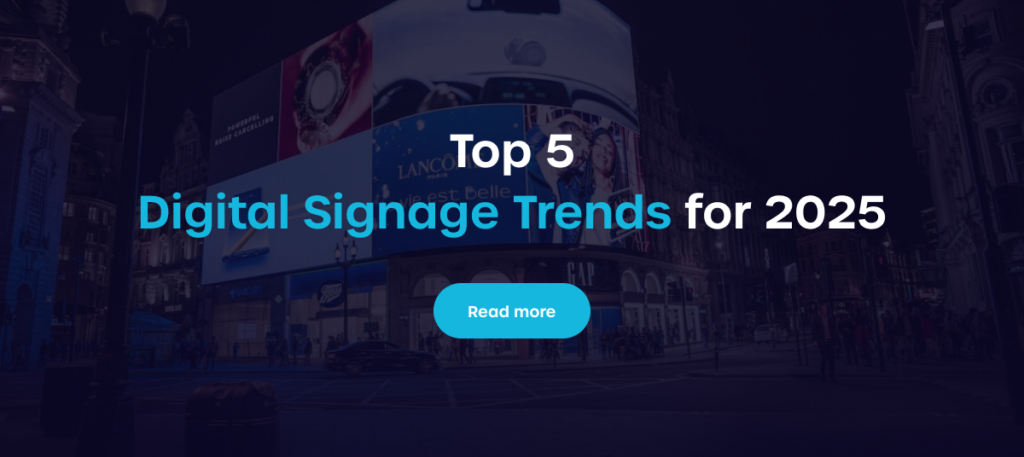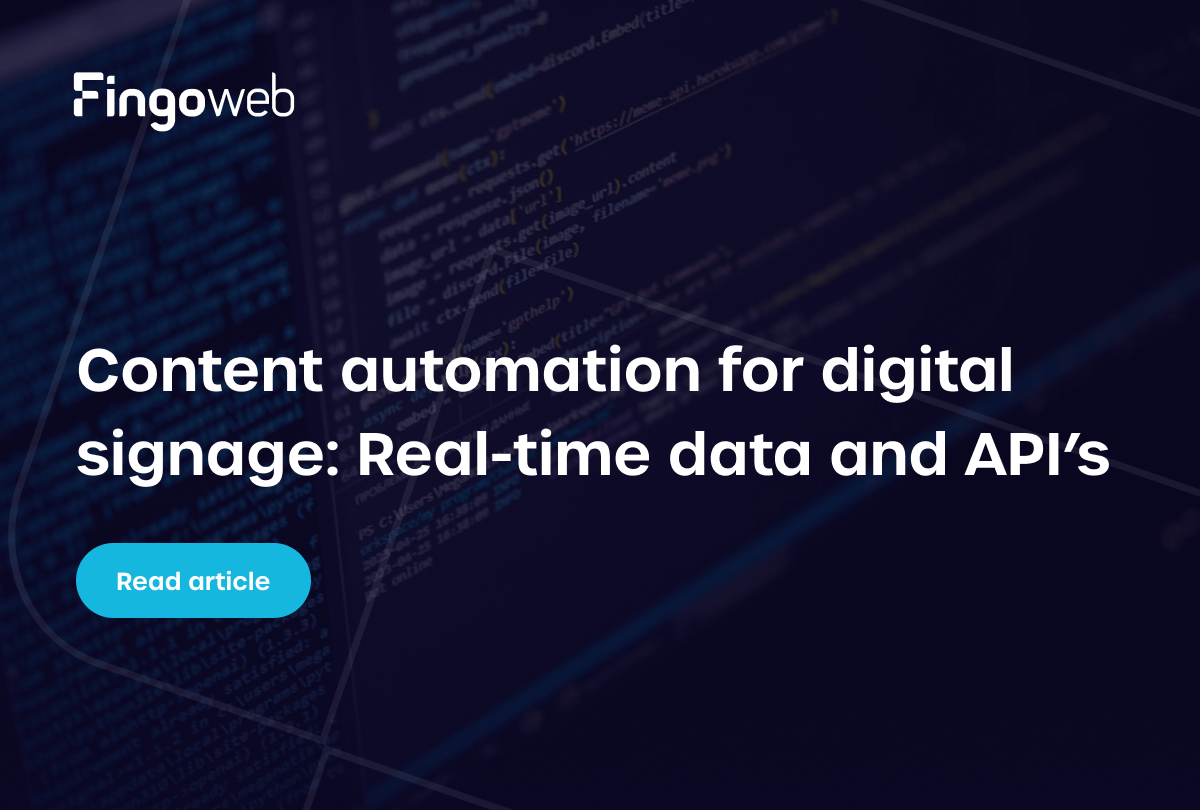In our publication about the future of digital signage, we pondered the industry’s development possibilities. One of the significant directions is the personalization and interactivity of digital signage campaigns and the development of receivers. How does AI in digital signage fit into all of this?
Table of contents:
- What do we mean by AI?
- #1 Analysis of large datasets and A/B testing
- #2 Content selection for audience groups
- #3 Recommendations
- #4 Sentiment analysis
- #5 Interactivity
- AI at every step
- The bottleneck = data
- Generating digital signage content
- AI around the corner in digital signage
AI is sweeping through various industries, and digital signage is no exception. The near future may bring many interesting changes. Three directions with great potential are:
- Utilizing the new generation of displays, including transparent LED screens and micro LED.
- Personalization of content and its interactivity.
- Utilizing AI in content selection and creation.
The last point is so extensive and intriguing that today we will focus solely on it. The application of machine learning and AI in digital signage will not be a standard for a long time, but undoubtedly, more and more solutions will be based on AI in the future.
What do we mean by AI?
Artificial intelligence has been a buzzword recently, encompassing many solutions. AI is often interchangeably used with ML (Machine Learning) and DL (Deep Learning), which is incorrect.
- Artificial Intelligence (AI) is the broadest term, encompassing a range of solutions. When we talk about AI, we mean a program/tool/application capable of delivering results without external intervention and based on new data. Another simple definition suggests that an AI model is capable of “predicting the future”.
- Example: An AI model trained on a large dataset of banking data is tasked with predicting which bank customers are most likely to take out a loan. In the following year of operation, the model receives data from new customers, and despite the new dataset, it can still perform the assigned task.
- Machine Learning (ML) is a way of training on datasets where the program learns to achieve specific results.
- Example: From a dataset containing pictures of cats and dogs, the program must select cats. With each iteration, a correctly selected cat is a positive point, and an error is a negative point. After a certain number of iterations, the program should be able to determine what a cat is. This method of training ML models is called supervised learning.
- Deep Learning (DL) is a machine learning method that uses neural networks. We won’t delve into neural networks today.
In digital signage, AI can be utilized at various stages, from analyzing the effectiveness of A/B tests in campaigns to selecting and generating multimedia content or making decisions about what content to display based on audience analysis.
It's worth remembering:
Even seemingly simple solutions like automatic photo categorization on your phone use machine learning algorithms for this purpose.
Do you want to learn about more digital signage trends? Check out this article:

Possible applications of AI in digital signage
Not every solution needs to be a complex set of tools and sometimes good results can be achieved with simple algorithms. We will only use the “AI” term from now on.
IMPORTANT:
The following predictions may or may not come true. We are still in the early stages of integrating AI into digital signage.
#1 Analysis of large datasets and A/B testing
One direction for using AI in digital signage could be optimizing campaigns by analyzing large datasets and A/B test results. We can imagine an interactive, self-service kiosk in a fast-food restaurant, where different pictures of a cheeseburger are displayed alternately. The model analyzes which picture is clicked more often and selects it for the menu.
Let's go a step further: there's increasingly less hindrance to customizing content on the fly for a particular audience group.
#2 Content selection for audience groups
Sticking with the restaurant example, instead of selecting one picture, we could present different pictures of cheeseburgers to different audience groups. For instance, showing a picture of just the cheeseburger to people who already have fries in their basket, and a picture of the cheeseburger in a meal deal to people who don't have fries in their basket.
If our digital signage player were equipped with a camera, and the solution was sophisticated enough, the model could make decisions based on demographic data.
#3 Recommendations
Recommendations are another area where AI can assist digital signage. Recommendation models integrated with digital signage players will support consumers in making purchasing decisions – for example, in the aforementioned self-service kiosks.
#4 Sentiment analysis
A huge advantage of AI-based solutions is their speed and high effectiveness. Adapting digital signage content to gender and other defined appearance features is one thing, but real-time sentiment analysis based on emotions, facial expressions, and gestures is another step. Based on this, future digital signage campaigns can become no less effective than current online marketing campaigns.
#5 Interactivity
The above points are largely related to personalization. Interactivity will be another area where AI can significantly change the world of digital signage. It's easy to imagine now that with machine vision solutions, a viewer can control elements on the screen (e.g., browse a virtual product catalog without touching the screen).
AI at every step
Above are just a few examples of using AI in digital signage, and we can already observe a certain pattern. If we were to divide the creation of digital signage campaigns into stages, AI will be effective in:
- Data analysis for strategic planning of digital signage campaigns.
- Content creation (GenAI).
- Increasing interactivity and personalization, as a tool in an operational system.
The bottleneck = data
The most difficult challenge in creating effective AI-based solutions is access to large, high-quality datasets. Netflix can display personalized movie recommendations and dedicated covers only because it has detailed data on the movies and shows we've watched in the past.
Furthermore, Netflix's datasets will include the viewer's gender, what and when they watched, which part of a movie they rewound, and which parts they skipped. This is why, on Netflix, you'll find seemingly crazy recommendations like Romantic Vampire Movies from the 90s. Digital signage needs data – the more, the better.
All interactive digital signage devices, even those with touchscreens, are capable of collecting specific information (e.g., a map in a shopping mall about the most searched-for store at specific hours).
The problem arises with passive players, and the solution will be cameras. Surely, this raises questions about the ethics and legality of recording every passerby near a digital signage screen.
Generating digital signage content
Generative AI has stormed into the public opinion as a magical solution to many creative issues. GenAI in digital signage can help with:
- Creating text content, captions, slogans, product descriptions.
- Generating graphics and images.
- Creating videos, as discussed below.
This year, OpenAI introduced a new model called Sora, which can generate realistic videos from simple prompts. We can imagine a future where digital signage campaigns are fully or partially supplemented with generated content.
Just check out this demo:
AI around the corner in digital signage
The future of AI in digital signage is very exciting and could revolutionize the industry, provided there is access to large datasets. AI will be used not only in planning strategies or analysis, but also in increasing interaction and personalization in digital signage.


Frequently Asked Questions
Will AI appear in digital signage?
Yes, and the first AI-supported players are already appearing on the market. The implementation of AI in digital signage will go hand in hand with changing screens and new formats (AR/VR).
At which stages of creating a digital signage campaign will AI be used?
AI will be useful at every stage of creating a digital signage campaign, from strategy through analysis to generating content.
What will be most important in promoting AI in digital signage?
Above all, data availability, which currently seems to be the biggest limitation.






